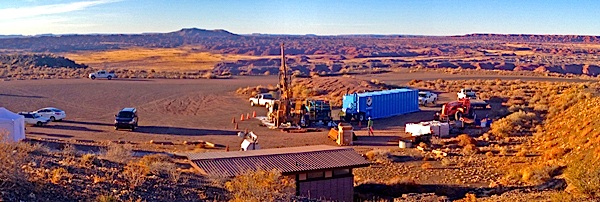
The first core drilling being done at Chinde Point in Petrified Forest National Park. NPS photo.
What did the Colorado Plateau look like 250 million years ago? That's a question geologists hope to shed some light on via an ambitious project that is pulling rock cores up from as much as 1.5 kilometers down into the plateau's belly.
The Colorado Plateau is an expansive region, taking in parts of Colorado, Utah, Arizona, and New Mexico. Within this geologic province are some of our most iconic national parks: Arches and Canyonlands, Bryce Canyon and Zion, the Grand Canyon and Petrified Forest to name the most recognizeable. What makes them so stunning is the geology from which they rise.
But what lies below those spectacular cliffs, buttes, plateaus and arches? Through the Colorado Plateau Coring Project, geologists hope to peer into buried layers of the plateau.
Led by geologist Paul Olsen, the project team over a five-year period will take cores from a half-dozen sites across the Colorado Plateau.
"This is expected to provide the big picture from 250 million to 145 million years ago, representing key crises in Earth's history: the ascent of dinosaurs, origins of modern ecosystems, and several sudden extinctions of much life," a release from Petrified Forest National Park said. "Among other things, the cores should help scientists grasp possible links between climate changes, extinctions and major evolutionary events."
The first core drilling was performed in Petrified Forest at Chinde Point.
You can learn more about the project at this site, and following the geologists' progress at this site.

 Support Essential Coverage of Essential Places
Support Essential Coverage of Essential Places







Comments
NPT Staff,Mr. Paul Olsen;
I'm interested in your core project on the Colorado Plateau.
Was the drilling ever completed? Are core descriptions and interpretations available? Thanks for any information.
Paul Denney, Professor of Geology, Pueblo Community College
Paul--
NPT won't know much unless Kurt decides to do a followup.
It appears you can find the progress of that core and some publications at:
http://www.ldeo.columbia.edu/~polsen/cpcp/CPCP_home_page_general.html
Paul Olsen's page at Columbia / Lamont-Doherty is http://www.ldeo.columbia.edu/~polsen/nbcp/peo.cv1.html
http://www.ldeo.columbia.edu/~polsen/nbcp/08-45_4603_olsen_chinle_salt_o... looks like a cool presentation, but I'm an ecologist, not geologist, so claiming to understand 1% of it may be an overestimation.
Is email address is there somewhere, too.
I hope that this helps...